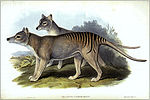 | Ostracods, or ostracodes, are a class of the Crustacea (class Ostracoda), sometimes known as seed shrimp. Some 33,000 species (only 13,000 of which are... 35 KB (3,684 words) - 20:43, 27 April 2024 |
Ostracod Limestone may refer to: Kilmaluag Formation or Ostracod Limestone, a Middle Jurassic geologic formation in Scotland Ostracod Beds or Ostracod... 375 bytes (75 words) - 12:29, 26 October 2020 |
2018 in arthropod paleontology (section Ostracods) (2018). A large-sized (12.9 mm maximum length) right valve of a marine ostracod is described from the Cretaceous amber from Myanmar by Xing et al. (2018)... 175 KB (9,235 words) - 08:52, 7 March 2024 |
 | Gigantocypris (redirect from Giant ostracod) Gigantocypris, sometimes known as giant ostracod or giant seed shrimp, is a genus of ostracod crustaceans in family Cypridinidae, and among the most well-known... 16 KB (1,573 words) - 22:07, 24 September 2023 |
Liocypris grandis is a species of ostracod which was long presumed extinct. It was rediscovered in the Western Cape of South Africa in 2003, having not... 3 KB (198 words) - 02:52, 16 March 2024 |
Mannville Group (redirect from Ostracod Beds) eastern Alberta and western Saskatchewan. Natural gas is extracted from the Ostracod and Glauconite beds in southern Alberta, and light oil is extracted from... 13 KB (674 words) - 21:32, 15 March 2024 |
This list of prehistoric ostracods is an attempt to create a comprehensive listing of all genera from the fossil record that have ever been considered... 46 KB (2,115 words) - 20:42, 1 April 2022 |
Scottia (crustacean) (redirect from Scottia (ostracod)) Scottia is a genus of ostracods in the family Cyprididae. Extant species: Scottia audax Scottia birigida Scottia insularis Scottia pseudobrowniana Fossil... 1 KB (90 words) - 00:21, 25 March 2022 |
 | Strophomenida, etc.), bivalves, cephalopods (nautiloids), trilobites, ostracods, bryozoans, many types of echinoderms (blastoids, cystoids, crinoids,... 172 KB (9,395 words) - 04:29, 22 April 2024 |
Muellerina (crustacean) (redirect from Muellerina (ostracod)) is a Cenozoic genus of ostracods in the family Hemicytheridae. The name is a tribute to German zoologist specializing in ostracod biology Christian Gustav... 2 KB (123 words) - 20:42, 10 June 2022 |
Carbonita (crustacean) (redirect from Carbonita (ostracod)) Carbonita is an extinct genus of nonmarine ostracod crustaceans that lived during the Carboniferous period. The genus contains four species: Carbonita... 2 KB (106 words) - 00:07, 25 March 2022 |
2024 in arthropod paleontology (section Ostracods) Triebelina, is published by Forel et al. (2024). Taxonomic revision of ostracods from the Lower Cretaceous Codó Formation (Brazil) is published by Coimbra... 42 KB (2,577 words) - 17:55, 28 April 2024 |
Maristella (crustacean) (redirect from Maristella (ostracod)) genus of ostracods belonging to the Myodocopida (Cypridinidae). The genus belongs to a diverse clade of Caribbean bioluminescent ostracods. Males perform... 3 KB (190 words) - 14:21, 7 March 2023 |
Potamocypris smaragdina is a species of ostracod crustacean in the family Cyprididae, subfamily Cypridopsinae. It is known from both Europe and North America... 2 KB (229 words) - 23:20, 24 April 2024 |
 | Geoarchaeology (section Ostracod analysis) Naturally occurring Ostracods in freshwater bodies are impacted by changes in salinity and pH due to human activities. Analysis of Ostracod shells in sediment... 13 KB (1,672 words) - 05:38, 6 July 2023 |
 | 2018). "High male sexual investment as a driver of extinction in fossil ostracods". Nature. 556 (7701): 366–369. Bibcode:2018Natur.556..366M. doi:10... 106 KB (11,259 words) - 09:36, 12 April 2024 |
 | and midwater species such as the squid Teuthowenia pellucida and the ostracod Macrocypridina castanea rotunda. Thus, the goblin shark appears to forage... 34 KB (3,943 words) - 01:54, 2 March 2024 |
palaeontologist who made major contributions to the study of Palaeozoic ostracods. Born in Poland, Franciszek J. Adamczak studied geology at the University... 6 KB (543 words) - 08:52, 31 December 2023 |












